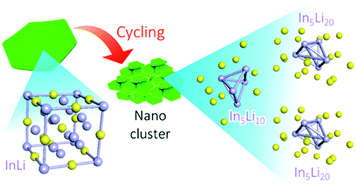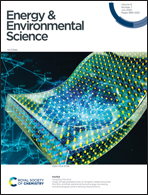Extra lithium-ion storage capacity enabled by liquid-phase exfoliated indium selenide nanosheets conductive network†
Abstract
As a recent addition to the family of van der Waals layered crystals, indium selenide (InSe) possesses unique optoelectronic and photonic properties, enabling high-performance electronic devices for broad applications. Nevertheless, the lithium storage behavior of InSe flakes is thus largely unexplored due to its low electronic conductivity and challenges associated with its exfoliation. Here, we prepare few-layered InSe flakes through liquid-phase exfoliation of wet-chemistry-synthesized layered InSe single crystals, and percolate the flakes with carbon nanotube (CNT) networks in order to form flexible anodes to store lithium (Li). We demonstrate, with the support of CNTs, that exfoliated InSe flakes possess superior Li storage capacity to bulk InSe; the capacity increases over prolonged cycling up to 1224 mA h g−1 from 520 mA h g−1, coupled with excellent rate handling properties and long-term cycling stability. The operando X-ray diffraction results suggest that the alloying of indium with Li dominates the Li storage reactions. By combining with density-functional theory calculations and post-mortem analysis, we believe that the in situ formed indium gradually reduces the domain size, forming nanoclusters which allow the accommodation of 4 Li+ per atomic indium, and leading to extra capacity beyond the traditional theoretical value. This new “nanoscluster alloying” Li storage mechanism may inspire new architectures or methods to synthesize few-layered InSe, thereby presenting broad opportunities for high-performance Li-ion battery anode technologies.



 Please wait while we load your content...
Please wait while we load your content...